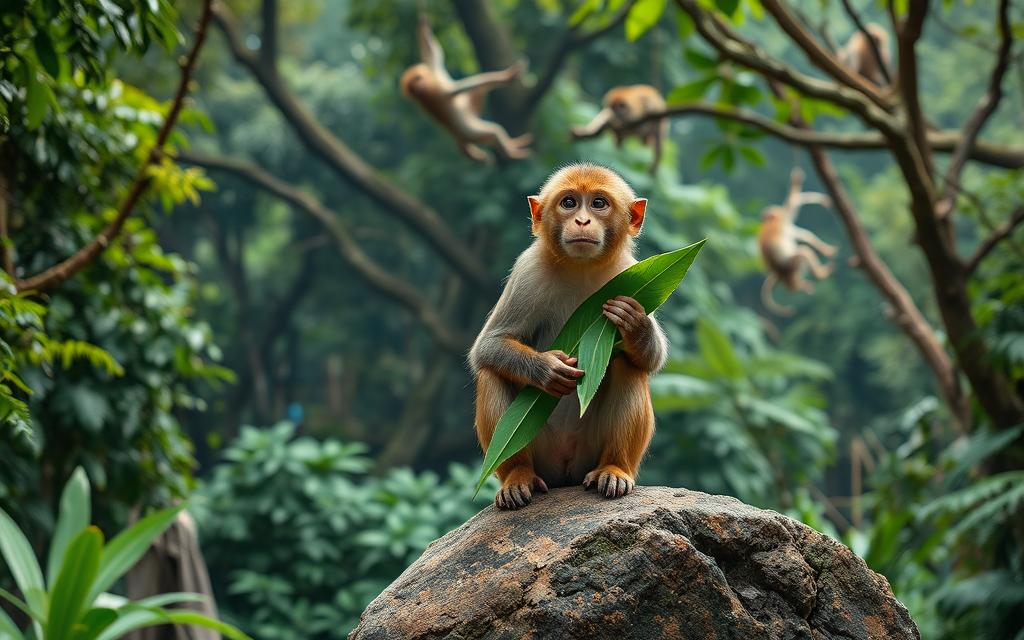
Ubud’s Monkey Forest Photography Tips: Capture the Magic
Did you know over 1,200 Balinese long-tailed macaques live in Ubud’s Monkey Forest? It’s as big as 31 football fields. This place is perfect for photographers who love capturing the playful nature of these monkeys in beautiful settings1. It’s great for both expert photographers and those just wanting to take special photos during their visit.
Getting into this famous place costs just over $5 USD on weekdays. It’s open every day from 9 AM to 6 PM. This gives you plenty of time to take amazing photos of the playful monkeys2. So, take your camera and let’s explore tips to make your visit unforgettable.
Key Takeaways
- There are over 1,200 long-tailed macaques in Ubud’s Monkey Forest.
- This sanctuary covers an area equivalent to 31 football fields.
- The entry fee is around $5 USD on weekdays.
- Plan your visit as the forest is open from 9 AM to 6 PM daily.
- Capture playful and candid moments with primates during your shoot.
Understanding Ubud’s Sacred Monkey Forest
The Sacred Monkey Forest of Ubud is a mix of nature and culture. It’s a top spot in your Ubud travel guide. Here, over 600 playful monkeys live among ancient temples and green trees. It’s a peaceful place for visitors to explore.
Inside, you’ll see 114 different species of trees. These trees make great photos and are home to the monkeys. Three Hindu temples from around 1350 show the forest’s cultural importance and beauty3.
The monkeys are a key part of the sanctuary. They eat sweet potato three times a day, thanks to the staff. But, be careful; tourists often get bitten. This shows why it’s important to be careful. The monkeys can get aggressive, especially in the late day3.
If you want to take photos, watch your stuff to avoid the monkeys. The Sacred Monkey Forest is full of life and history. It makes your trip to Ubud unforgettable.
Entrance Fee: 50,000 IDR (~$3.29 USD). From Canggu to the forest: around a 40-minute scooter ride. From Kuta: approximately 50 minutes to an hour depending on traffic.
Why Visit the Sacred Monkey Forest for Photography
The Sacred Monkey Forest is perfect for those who love primate photography. It covers 28 acres and is home to over 600 Crab-eating Macaques. This place is great for both new and experienced photographers4. The area is filled with greenery and ancient temples, making it a beautiful spot for photos5.
Here, you can see monkeys playing, giving you great chances to take real, fun photos. The sanctuary is split into four groups. Each group shows different family life and behaviors, offering many photo opportunities4.
Going during quiet times means fewer people around, so you can get amazing photos. The peaceful setting lets you really feel part of the place and its life. The mix of close wildlife and stunning views makes the Ubud Monkey Forest a must-see for photographers5.
Tips for Photographing in the Sacred Monkey Forest
Visiting the Sacred Monkey Forest is a great chance to take beautiful photos. It has vibrant wildlife and lush surroundings. Here are some tips to make the most of your visit.
Choosing the Right Time of Day for Optimal Light
The time you visit affects your photos a lot. Early mornings are best for photos. You’ll get stunning shots as monkeys are most active.
This time also has soft morning light and fewer people around.
Selecting Your Equipment for Best Results
Choosing the right gear is key for great photos. You’ll need a camera with a good zoom and fast shutter speed. A 24-105 mm f/4 lens is good for versatility.
Also, a tripod is useful for low light.
Techniques for Capturing Candid Animal Shots
To get good shots of monkeys, focus on candid photos. Wait and watch without scaring them. Use a shallow depth of field to blur the background.
This makes your photos more interesting. Try shooting from different angles for unique shots.
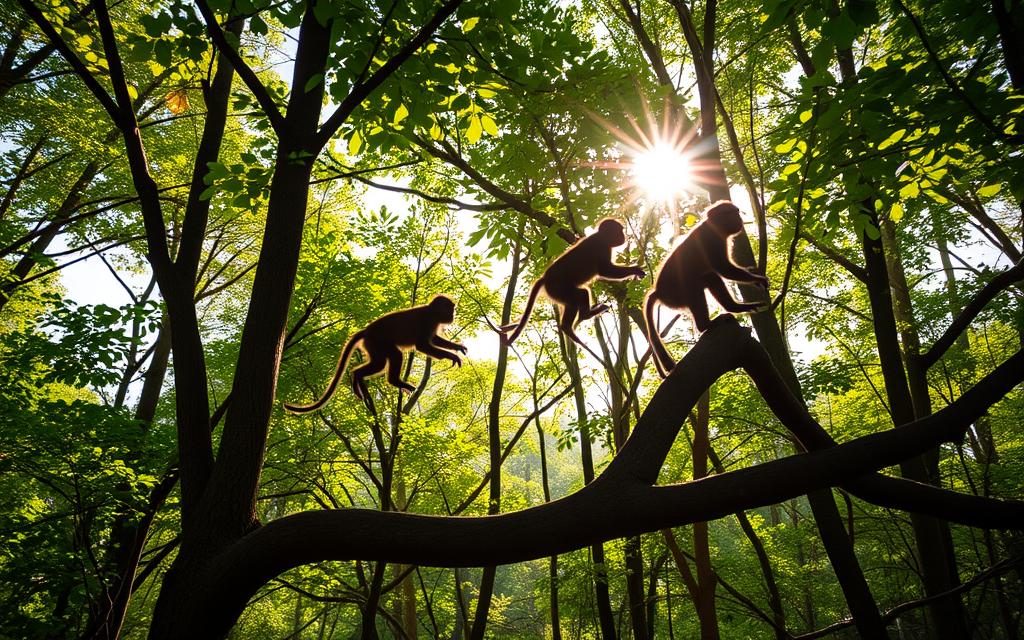
Always be respectful to the animals and follow the rules. This keeps you safe and protects the animals678.
Composing Nature Scenes in the Monkey Forest
When you go into the Sacred Monkey Forest, your creativity and awareness are key. Use the natural elements around you to improve your photos. This makes your pictures stand out.
Using Natural Elements for Framing
Use trees, leaves, and paths as frames in your photos. This adds depth and shows the forest’s beauty. Look for branches or leaves that lead the viewer’s eye to your subject.
This makes your photos feel like you’re right there in the forest. It pulls your audience into the magical world of the forest.
Incorporating Monkeys into Your Composition
Don’t forget to include monkeys in your shots. Putting them in the right spot in your photo tells a story. Incorporating monkeys adds a fun and lively touch to your photos.
Try to get candid shots that show how they interact with their surroundings. This adds real life to your photos.
Understanding Outdoor Photography Lighting
In Ubud’s Sacred Monkey Forest, learning about outdoor photography lighting is key. It helps you capture the beauty around you. Working with natural light in the jungle can make your photos look amazing.
Utilizing Available Light to Enhance Your Shots
Using light well is crucial, especially in the treetops where sunlight is hard to get through. Try shooting in the early morning or late afternoon for warm, golden light. You might need to change your camera settings because of the dense foliage. Most cameras work well at ISO values from 2000 to 4000, which is needed in the forest’s low light9.
Working with Shadows and Highlights in the Jungle
Shadows and highlights are key in the Jungle. Shadows add depth and drama, while highlights show off the monkeys’ fur or the plants’ colors. Try different angles to get the right mix. In the middle of the day, the light can be too harsh, causing big contrasts. Use fill-in flash or find shaded spots for softer light9.
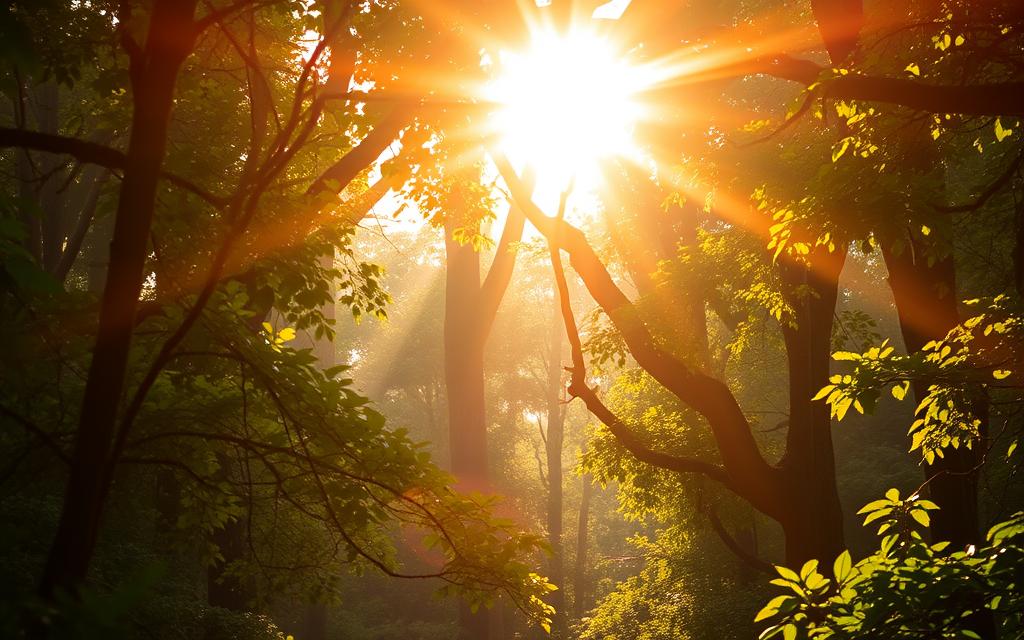
Monkey Forest Etiquette for Photographers
When you visit Ubud’s Monkey Forest, it’s key to know the rules for your safety and the monkeys’ well-being. The place is home to about 600 monkeys. It’s important to keep a safe distance when you’re watching or taking pictures of them10. Remember, they’re not just for photos; they are living beings that deserve respect and care.
Don’t feed the monkeys, as it can cause bad reactions and stress11. Take off any loose items and jewelry before going in to stop theft. Monkeys are curious and smart10. Keep your things safe and don’t bring plastic bags or food to enjoy your visit without trouble.
If a monkey comes close, stay calm. Just keep moving and don’t worry about it10. Also, don’t look into their eyes as signs say not to, to avoid making them act aggressive10.
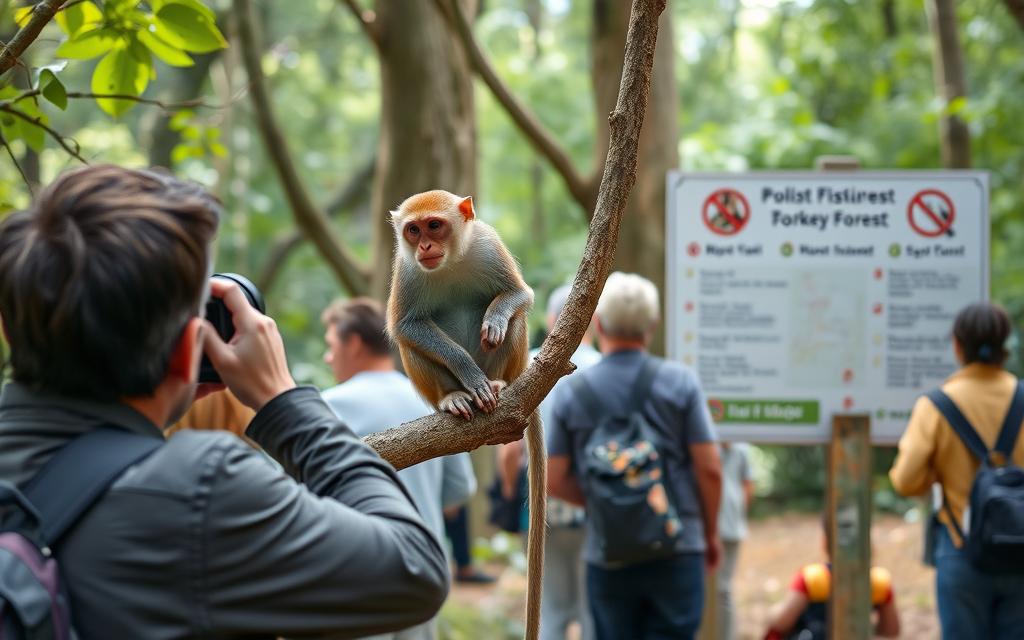
When taking pictures, aim for moments that show the monkeys in their natural setting without disturbing them11. This way, you get great shots and help protect the forest’s ecosystem. Being a responsible photographer means caring for wildlife and sharing its beauty with others.
Making Ethical Wildlife Images in the Sacred Forest
When you visit the Sacred Monkey Forest, it’s key to make ethical wildlife images. You can take amazing photos while keeping the animals safe and their homes respected. By being safe with the monkeys, you can record their actions without upsetting them.
Respecting Wildlife and Their Habitats
Over 1,000 long-tailed macaques live in this sanctuary12. Each monkey is important to the forest’s balance. It’s vital to respect their space and not feed them. This keeps them wild and helps protect their homes.
By not feeding them, you help keep these amazing animals and their homes safe.
Engaging with Monkeys Safely
When taking photos, focus on safe engagement. Don’t use flash or make sudden moves, as they scare the monkeys. Be calm and wait for the perfect shot. Your goal is to watch them without changing their behavior.
Watching them from afar lets you capture real moments. This way, you make ethical wildlife images that show their true selves13.
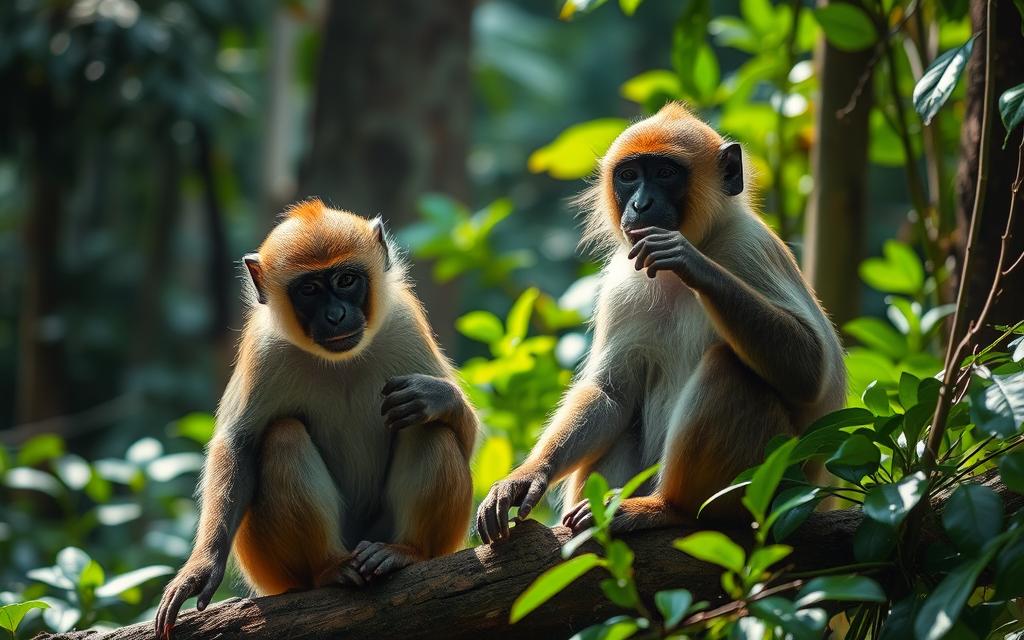
Preparing for Your Visit to the Monkey Forest
Planning your trip to the Monkey Forest makes your visit better and helps you take great photos. This guide gives you tips for traveling to Ubud and what photography gear you should bring. This way, you can enjoy your time in this beautiful place fully.
Getting There: Travel Tips to Ubud
Your trip to Ubud can begin at Ngurah Rai Airport, a 1.5-hour drive away. Or, if you’re coming from Denpasar, it’s about an hour’s drive. Make sure to visit during the Monkey Forest’s open hours, from 9:00 AM to 5:00 PM14. This lets you get the best shots. The forest is big, covering 12.5 hectares, and is home to over 700 macaque monkeys15.
Essential Items to Bring for a Successful Shoot
Having the right gear is key for great photos. Here are some must-haves for your camera:
- Extra batteries so your camera doesn’t run out when you need it most.
- Memory cards with lots of space so you don’t miss any special moments.
- Waterproof covers for your gear to keep it safe from rain or curious monkeys.
- Comfortable shoes for walking through the forest.
- A small, secure bag to keep your things safe from the monkeys.
Respecting the monkeys and following safety rules, like not feeding them, makes your visit better15. With the right prep, you’ll have a great time at the Monkey Forest. You can focus on taking amazing photos.
Exploring Beyond the Lens: Other Attractions in Ubud
Ubud is more than just the famous Ubud Monkey Forest. It has many attractions that show off its culture and beauty. You can see temples, rice terraces, and markets.
Visit the Tirta Empul Temple to see its Holy Spring Water. It’s a quiet place where you can learn about Balinese traditions. You can even take part in purification rituals.
For stunning views, go to the Tegalalang Rice Terrace. You’ll see beautiful rice fields and learn about farming in Bali. It’s perfect for taking amazing photos.
Don’t forget to check out the local markets. The Ubud Art Market has lots of handmade crafts, textiles, and fresh food. It’s a great way to support local artists and shop for unique items.
For culture lovers, see a traditional dance at the Ubud Palace. The dances tell stories of Bali’s myths and legends. It’s a truly magical experience.
In conclusion, there’s so much to see beyond the Monkey Forest in Ubud. Take the chance to explore and enjoy all that this magical place offers.
Sharing Your Photography: Connecting with the Community
Sharing your photos can connect you with people all over the world. It lets you show off your work and get inspired by others. Sites like Instagram, Flickr, and forums are great for sharing and getting feedback.
When you share your photos, you build connections. You share stories and tips with others. This helps everyone grow and feel part of a community.
Your photos add to the world’s knowledge of nature. They can motivate new photographers to visit Ubud and share their stories. Sharing your view of the forest can lead to lasting friendships and partnerships. As you keep sharing, you learn more and enjoy the process1617.
Conclusion
Your trip to Ubud’s Sacred Monkey Forest can be a great chance to take amazing photos. By following the photography tips in this article, you’ll make your Ubud trip unforgettable. You’ll get to capture the beauty of the place and its playful monkeys1819.
It’s important to be respectful and thoughtful in the forest. This way, your photos won’t harm the monkeys or their homes. By being ethical, you help protect the monkeys and keep the forest beautiful.
Your photos in Ubud are more than just pictures. They tell stories and keep memories alive. This careful way of taking photos helps you remember your trip. It also connects you more deeply to the forest’s beauty and culture20.
FAQ
What is the best time to visit the Sacred Monkey Forest for photography?
Early mornings are best for photos. The light is soft, and there are more monkeys around with fewer people.
Do I need special equipment for photographing monkeys in the forest?
A camera with a good zoom and fast shutter speeds is good. Smartphones work too. Don’t forget extra batteries and memory cards.
How can I ensure I capture candid shots of monkeys?
Be patient and keep a safe distance. Let them act naturally. Click when they interact with each other.
What should I keep in mind about monkey forest etiquette while photographing?
Keep a safe distance and don’t feed or bother the monkeys. Always think of your safety and theirs.
Are there any tips for composing my photos in the Monkey Forest?
Use trees and paths to frame your shots. Place the monkeys in your photo thoughtfully for balanced shots.
How does outdoor lighting affect my photography in the Monkey Forest?
Natural light adds dynamic shadows and highlights. Use the light to brighten your photos. Choose the best time of day for great shots.
Can I photograph any animal in the Monkey Forest?
Focus on the monkeys, but watch out for other wildlife. Make sure you’re not disturbing their natural life or space.
What other attractions should I visit in Ubud after the Monkey Forest?
Ubud has temples, rice terraces, and markets. These places add to your trip and give more chances to take photos.
How can I connect with other photographers after my visit?
Post your photos on Instagram or photography forums. You can get feedback, share stories, and meet other photography fans.
What is the importance of making ethical wildlife images?
Ethical wildlife photos show respect for animals and their homes. They reduce stress on wildlife and encourage sharing nature’s moments responsibly.
Source Links
- https://destinationlesstravel.com/ubud-monkey-forest-bali/
- https://www.pelago.com/en/activity/pk0fc-ubud-sacred-monkey-forest-sanctuary-guided-walking-tour-bali/
- https://www.travelphotographyguru.com/travel-blogs/sacred-monkey-forest-sanctuary
- https://www.minoritynomad.com/blog/only-reason-to-visit-ubud-sacred-monkey-forest-sanctuary
- https://sandsunandmessybuns.com/visit-monkey-forest-sanctuary/
- https://www.travelphotographyguru.com/travel-blogs/wounded-monkey-in-ubud-bali
- https://www.saltinourhair.com/bali/ubud-monkey-forest/
- https://www.acouplescalling.com/the-sacred-monkey-forest-sanctuary-in-ubud/
- https://www.naturettl.com/rainforest-photography-lighting/
- https://www.shannondidwhat.com/blog/ubud-monkey-forest
- https://balifloatingleaf.com/visit-bali-monkey-forest/
- https://www.sunshineseeker.com/destinations/monkeys-in-bali/
- https://monkeyforestubud.com/guidelines-faq/
- https://www.traveloka.com/en-au/activities/indonesia/product/monkey-forest-ubud-tickets-5434637470362
- https://www.myvillasinbali.com/explore-monkey-forest-in-bali/
- https://digital-photography-school.com/travel-inspiration-bali/
- https://finnsbeachclub.com/guides/monkey-forest-ubud/
- https://authenticbalitours.com/monkey-forest-bali-glossary-ubud/
- https://zimminaroundtheworld.com/ubud-monkey-forest/
- https://omkaraexperience.com/bali-unveiling-paradise-3/